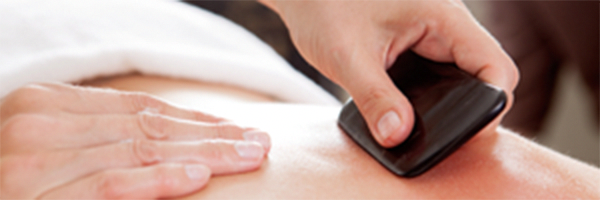Cupping 
Cupping is an ancient technique, used in many cultures, in which a special cup is applied to the skin and held in place by suction. The suction draws superficial tissue into the cup, which may either be left in place or moved along the body. Cupping brings fresh blood to the area and helps improve circulation. Traditional cupping, sometimes referred to as “fire cupping," uses heat to create a vacuum-like suction inside of glass cups. In modern times, cups that use a small pump to create suction have also been introduced.
Cupping may leave red, purple, or, in some cases, black marks on the body which dissipate within 2-10 days on average. The darker the color, the longer it will take your body to clear. The color is diagnostic as well as therapeutic and can tell us 3 basic things. First, it tells us where the problem is. Some skin under the cups will color and some won't, although the same amount of suction as been applied. Second, cupping tells us the kind of problem we are dealing with. If the problem is related to toxin build up or muscle spasm, color will come up under the cups. Issues related to nerve and bone will not color at all. Third, cupping tells us the severity of the problem. Light or moderate blockage will cause the skin under a cup to color pink or red, and it will take 1-2 days for this color to fade. Severe stagnation can cause the skin to color a deep scarlet, purple, or even black, and can take up to 2 weeks to clear.
Cupping can produce mild to moderate discomfort while the cups are in place. Although the marks left may look painful, in most cases they are not. I always work within your level of comfort, providing the most amount of benefit with the least amount of discomfort.
GuaSha

Gua sha is a healing technique of traditional East Asian medicine. Sometimes called ‘coining, spooning or scraping’. Lotion or oil is first applied to the skin, then a ceramic soup spoon or similar instrument with a rounded edge is used to apply pressure in a downward motion over the area being treated. This creates pinpoint spots known as sha that can be red, purple or brown. As with cupping, the color of the spots indicates the severity of the condition. This therapy moves stagnant blood out of the tissues, stimulating circulation by bringing newly oxygenated blood to the area which supports regeneration and healing.
Modern research shows this produces an anti-inflammatory and immune-protective effect that remains for days following a single Gua sha treatment. Patients feel immediate relief from pain, stiffness, fever, chill, cough, wheeze, etc. Gua sha is effective in acute and chronic internal-organ disorders.
Moxibustion 
Moxibustion involves the heating of acupuncture points with smoldering mugwort herb (known as moxa). Moxibustion stimulates circulation, counteracts cold and dampness in the body, and promotes the smooth flow of blood and qi. This safe, non-invasive technique may be used alone, but it is generally used in conjunction with acupuncture treatment. To reduce smoke and odor, I use smokeless moxa, which is a charcoal stick embedded with tightly compressed mugwort herb.
Tuning Forks
Although not a traditional modality of Oriental Medicine, tuning forks work with the body's bioelectric field. This therapy is an exceptional tool for supporting the body, mind, and spirit.



